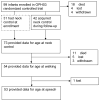Correlates of age at attainment of developmental milestones in HIV-infected infants receiving early antiretroviral therapy
- PMID: 25144793
- PMCID: PMC4336221
- DOI: 10.1097/INF.0000000000000526
Correlates of age at attainment of developmental milestones in HIV-infected infants receiving early antiretroviral therapy
Erratum in
- Pediatr Infect Dis J. 2015 Aug;34(8):892
Abstract
Background: Infant HIV-1 infection is associated with impaired neurologic and motor development. Antiretroviral therapy (ART) has the potential to improve developmental outcomes but the relative contributions of pre-ART disease status, growth, treatment regimen and ART response during infancy are unknown.
Methods: Kenyan ART-naive infants <5-months old initiated ART and had monthly assessment of age of full neck control, unsupported walking and monosyllabic speech during 24 months of follow-up. Pre-ART and post-ART correlates of age at milestone attainment were evaluated using t tests or multivariate linear regression.
Results: Among 99 infants, pre-ART correlates of later milestone attainment included: underweight and stunted (neck control, walking and speech, all P values <0.05), missed prevention of mother-to-child transmission (P = 0.04) (neck control), previous hospitalization, World Health Organization (WHO) Stage III/IV, low CD4 count, and wasting (speech and walking, all P values <0.05), and low maternal CD4 (speech, P = 0.04). Infants initiated ART at a median of 14 days following enrollment. Infants receiving nevirapinevs lopinavir/ritonavir-based ART attained later speech (18.1 vs. 15.5 months, P = 0.003) [corrected]. Adjusting for pre-ART level, lower 6-month gain in CD4% was associated with later walking (0.18 months earlier per unit increase in CD4%; P = 0.004) and speech (0.12 months earlier per unit increase in CD4%; P = 0.05), and lower 6-month gains in weight-for-age (P = 0.009), height-for-age (P = 0.03) and weight-for-height (P = 0.02) were associated with later walking.
Conclusion: In HIV-infected infants, compromised pre-ART immune and growth status, poor post-ART immune and growth responses, and use of nevirapine- vs. lopinavir/ritonavir-based ART were each associated with later milestone attainment [corrected]. The long-term consequences of these delays are unknown.
Conflict of interest statement
Figures
References
-
- Wachsler-Felder JL, Golden CJ. Neuropsychological consequences of HIV in children: a review of current literature. Clin Psychol Rev. 2002;22(3):443–464. - PubMed
-
- Tardieu M. HIV-1 and the developing central nervous system. Dev Med Child Neurol. 1998;40(12):843–846. - PubMed
-
- Drotar D, Olness K, Wiznitzer M, et al. Neurodevelopmental outcomes of Ugandan infants with human immunodeficiency virus type 1 infection. Pediatrics. 1997;100(1):E5. - PubMed
-
- Gay CL, Armstrong FD, Cohen D, et al. The effects of HIV on cognitive and motor development in children born to HIV-seropositive women with no reported drug use: birth to 24 months. Pediatrics. 1995;96(6):1078–1082. - PubMed
Publication types
MeSH terms
Substances
Grants and funding
LinkOut - more resources
Full Text Sources
Medical
Research Materials


